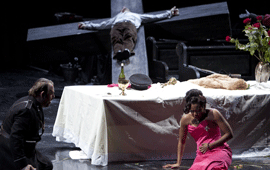> [Archived] Chronicles

The New 'Tosca' at the Cologne Opera
Most artists performing on stage - be them theatre or opera artists - believe that it takes time for a new production to "settle down", so as all the people involved in it to feel at ease in the new mise en scène, with their new colleagues and sometimes on an unfamiliar stage.
Following to this unwritten rule, I have, on purpose, missed the premiere of "Tosca" presented by the Cologne Opera on 17th May, 2012 and directed by Thilo Reinhardt, choosing instead to see their fourth representation on Sunday, 27th May. Since the Opera House is undergoing renovation, the institution has been temporarily moved into the Musical Dome - a building located in the vicinity of the Dome and the Rin River in a building that I can only describe as a furnished hangar.
The performance was officially due to begin at 19.30, so I entered the hall ten minutes earlier and I was extremely surprised to see that a sermon was being held on stage, in a church like décor. For a few moments I was taken aback, thinking I was late and, even though the audience continued to arrive, the orchestra was not in the orchestra pit. Could the sermon have had double meaning, one beyond the theatrical space - considering that the performance was held in Germany on Whitsunday? Very unlikely, I would have to admit. I think it had more to do with some idea the producer had, though its true purpose remains hidden. Because, if the producer had set his mind to unravel as soon as possible the only piece of décor used for the entire performance…then his decision was uninspired. This new version of Puccini's love tale places the triangle Floria Tosca - Mario Cavaradossi - Scarpia in a fascist Rome and has vulgar and tragicomic accents. As I was saying before, all the acts take place in the same church-like décor presented in the beginning, a holy place that transforms itself throughout the play into a cursed one, starting with Sarpia's first appearance; the director insisted on the Baron's demonic character.
One of the moments I consider to pertain a very questionable taste was the one in which Mario was tortured - a moment that has been rendered there as a crucifixion, with all its elements: the crown of thorns, the nails being hammered in his palms and even the spear that pierced his chest; afterwords there was Scarpia's death who, surprisingly, did not die the first time around, even though he had been shot by Tosca, but still had the power to rise up after the first bullet hit him and threaten Floria, who, surrendering, was prepared to give into him. But the tragicomedy did not end there, because Tosca's famous line "E avanti a lui tremava tutta Roma!" - "And before him all Rome trembled!", traditionally and logically said after Scarpia's death, in this production was an insult to the Baron's masculinity, who had suddenly felt disgusted by the woman standing in front of him, had tried to exit the church and had been shot once again - a fatal shot this time.
Needless to say that due to this and to several other distasteful artifices, the connection between the musical discourse and the histrionic one becomes a joke.
Entirely inadequate was also distributing Takesha Meshe Kizart as title rolist. The African-born American artist has a nice timbre, but with severe sustain and intonation issues, this is the reason why Tosca's vocal score was unintelligible.
Bass-baritone Oliver Zwarg was not the best choice for Scarpia either, on account of his timbre.
Tenor Cãlin Brãtescu - interpreting Mario Cavaradossi - was the one who made me believe that the evening was not entirely a loss. And I am not just saying this out of patriotism, but I am convinced that Brãtescu the only one worth listening to in this production.
Translated by Mihaela Melneciuc
MTTLC, Bucharest University














